
Arrangements at a death in Victorian and Edwardian England
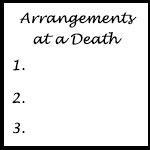
In Victorian England, what had to be done when someone died was different from today. This page describes and comments on the arrangements that ordinary people had to make when faced with a death: contacting an undertaker and minister to take the funeral service, arranging for the laying out and the coffin, storing the body before the funeral, announcing and registering the death, ordering flowers, borrowing or buying mourning clothes, particularly widow's weeds, and locating any will.
____
Extracted from the memoirs of the webmaster's mother(1906-2002) and edited by the webmaster with further research and firsthand contributions from others
When I was a child in the early 1900s, there was always a lot to do when someone died. The one positive thing was that it took the mind off the immediate grief.
Contacting the undertaker
The first thing to do was to get a message to the local undertaker. He would bring the shell of a temporary coffin to the house and organise the permanent one which would probably be made by craftsmen in his own workshop.
The undertaker might also suggest a woman to lay out the body - see below - unless the family chose to do it.
Choosing a coffin and its accessories
Families generally tried to show love and respect for the dead person by not scrimping on the quality of the coffin - also known as the casket outside the UK. The fact that it would only be seen for a short time before being buried didn't seem to matter as much as that it would be seen by relatives, neighbours and friends in the parlour, during the funeral procession and at the burial. They would remember and talk. Hardwoods like oak were strong and durable, and soft woods from fast growing trees like pine were cheap, but the coffin could be made of any type of wood and the cost depended on local availability and what the family could afford.
Hinges, handles and other embellishments also needed to be agreed because they could be quite ornate. The undertaker kept a stock of them, mostly in brass. The decision again depended on what they family could afford.
Then there were the accessories to make the body look comfortable and peaceful, like a pillow, and padded fabric - usually satin - for the body to lie on.
Although safety bells on coffins seem popular in stories and films, I never saw one or knew of one - and I saw a lot of coffins in funeral processions and at burials. The idea was that a string or wire would be placed in the hand of the body, so that if he woke up he could pull on a bell as an alert that he needed assistance. The fear was said to be that the body could wake up, as tests for death were not always accuate.
Laying out the body
'Layout out the body' also known as 'performing the last offices' meant preparing the body for burial and for visitors to come and pay their respects to it. It was normally performed by a woman who was experienced in such matters and was done as soon as possible after death. If the eyes were open, the woman would close them and if necessary keep them closed by placing pennies on top - remember that pre-decimal pennies were much larger and heavier than the post decimal 1971 ones. Also, if the mouth was open, she would close it with bandages tied under the chin and over the head. After some hours, both of these tasks would have done their job and could be removed to make the body appear more presentable. She also undressed and washed the body and dressed it in its burial clothes. What these were depended on the norms of the family's social class. Finally the body was laid on some appropriate fabric in the permanent coffin, ready for viewing.
'Lying in state' in the parlour
The body in its permanent coffin would stay at home in the parlour for about a week, somewhat akin to lying in state. It gave time for the funeral arrangements to be made and for visitors to view the body and pay their respects. This can't have been a pleasant experience, especially in hot weather with no air conditioning, but, being a child at the time, I was never allowed in to go in to see. I understand, though, that in some very traditional households, children were forced in to kiss the corpse - something that they never got over.
Arranging the funeral service with the minister
The minister of the family's religion was contacted to agree the funeral service and arrange a date and burial plot.
Announcing the death
The relations had to be informed of the death, and in those days we had to rely on the post, as the telephone was not for the likes of ordinary people. The custom which has long died out was to use black edged note paper and envelopes. When our parents received one of these envelopes, it was often their first intimidation that there was a death in the family.
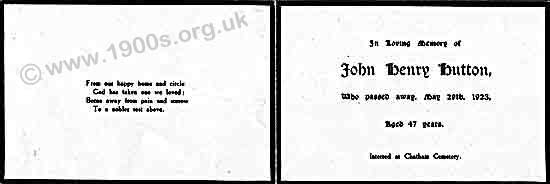
Card with a black edge which arrived through the post to notify of a death. This one is specially printed and dated 1923. Probably, though, in earlier times, blank cards were bought from newsagents and handwritten.
In real terms, postage was cheap because it had a high volume of usage, there being no phones for ordinary people, and only the better-off families would put a death notice in the newspaper.
Registering the death
Note from the webmaster
My mother's recollections say nothing about registering the death. Presumably this was something that she, as a child, was never involved in. In the early 1900s in England, deaths were registered with the General Register Office (GRO).
Under the Births and Deaths Registration Act of 1836, deaths had to be registered within five days of their occurrence. It required a death certificate from the attending doctor or his representative. Someone then had to take the death certificate to the Registrar of Births and Deaths in the district where the death occurred. He entered the information into the local death register, then issued a certified copy of the entry to the person who reported the death or his representative and a copy to the General Register Office (GRO), where it was entered in the national index.
Death certificates were important documents, particularly for insurance claims.
Acquiring the customary clothes for the funeral and mourning
The custom of the day was for the adults in the immediate family to wear all black clothes for the funeral and for the mourning afterwards. These had to be bought or borrowed. Where money was tight or no suitable clothes could be afforded or borrowed, a black armband had to suffice.
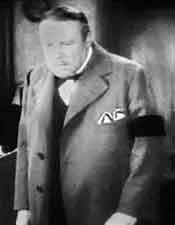
Man wearing a black armband, the symbol of mourning a dead relative or close friend. Note the black edged handkerchief.
Children did not wear black. We wore a black armband on a coat sleeve, as did distant relatives.
Widow's weeds
The funeral and mourning clothes of widows were known as widows' weeds, but other women in families might also think it appropriate to wear them. The origin of the term is lost in time, although various suggestions have been proposed. Widow's weeds were long and black, and always included veils of black tulle (a semi-transparent net) about 2 ft [600 mm] square attached to their black hats. These veils were pulled over the face for the funeral service and burial, but usually hung down the back afterwards.
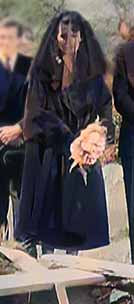
Woman in widows weeds - all black with a black tulle veil.
They were worn for about three months which was the recognised time of mourning for ordinary people like us. Grey was considered as half-mourning which took over after the period of the full three month mourning.
Queen Victoria was known to wear full widow's weeds for 40 years after the death of her husband, Prince Albert, with whom she was said to be passionately in love.
Flowers for the coffin and grave
Flowers for the coffin had to be ordered from a florist. Flowers for the grave were usually donated.
Artificial wreaths were quite fashionable at the time. These were about the size of a family cake and consisted of wax flowers attached to a base and covered with a glass dome case. The donor's card was inside. These wreaths could remain on the grave for a number of years, but they did bleach in the sun.
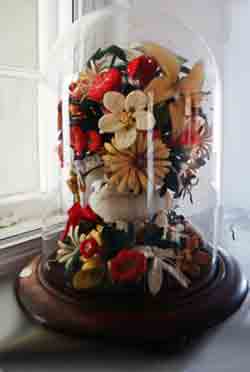
Wax flowers in a glass dome, common on graves. Photographed in Sun Hill Museum.
It was customary for neighbours to collect for a wreath, usually about three [old] pence per house.
Locating the will if one existed
Poor people and many ordinary people seldom made wills because they had little or nothing to leave. I have no idea if my father left a will. I do know that it was just assumed that my brothers would chip in to support my mother and that I, as the only daughter, would welcome her into my husband's and my home.
If you can add anything to this page or provide a photo, I would be pleased if you would contact me.
Text and images are copyright
sources: early 20th century material
sources: ww2 home front and other material
contact
the webmaster/author/researcher/editor
privacy policy
















